Community Embraces New Word Game at Mid-Year Play Day This past Sunday, families at Takoma Park’s Seventh Annual Mid-Year Play Day had the opportunity to experience OtherWordly for the first time. Our educational language game drew curious children and parents to our table throughout the afternoon. Words in Space Several children gathered around our iPads […]
Read moreTag: social media
 Getting the community involved in contributing content to an online project is a great form of public participation, and also a way to build large repositories of content. However, the underbelly of community-generated content is bad taste, inappropriate content, and outright abuse.
Getting the community involved in contributing content to an online project is a great form of public participation, and also a way to build large repositories of content. However, the underbelly of community-generated content is bad taste, inappropriate content, and outright abuse.
This seedy side is particularly evident in social networks sites, where users upload photos from their cell phones. To keep it clean, social media sites hire legions of inexpensive laborers via crowdsourcing sites like Amazon’s Mechanical Turk and CrowdFlower to screen uploaded content. (more…)
- Posted in Communication
- No Comments
- Tags: Amazon Mechanical Turk, CrowdFlower, moderation, planning, social media
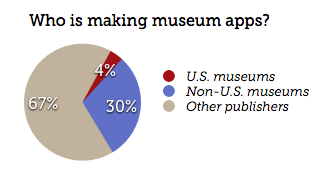 The vast majority of museums are totally ignoring mobile apps.
The vast majority of museums are totally ignoring mobile apps.
At present, ~350 iPhone apps have been actually created by museums. Of those, only one out of ten was created by a U.S. museum (the rest are non-U.S.). The other 760 iPhone apps matching “museum” in their title or description were created by travel and culture publishers, most of which are poor quality.
These pathetic numbers ignore smartphone reality. In the U.S. alone, half of all mobile phone customers now have smartphones, and there will soon be 1 million new smartphone (smartphones run apps) subscribers a week. This will be virtually all U.S. households in 5-7 years. Currently, Android and iOS are the two main app platforms. Numbers in Europe are similar. (more…)
- Posted in Strategy
- 8 Comments
- Tags: access, Android, apps, iOS, iPhone, iTunes, mobile phone, museum, smartphone, social media, surveys
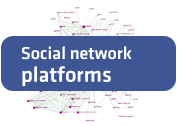 So you want to create a niche social network? And you’ve read the prior post on overall issues to consider? Here’s an overview of over a dozen software platforms you might consider. (more…)
So you want to create a niche social network? And you’ve read the prior post on overall issues to consider? Here’s an overview of over a dozen software platforms you might consider. (more…)
- Posted in Strategy
- 6 Comments
- Tags: Acquia, blog, BuddyPress, community, content management, Drupal, Facebook, INgage Networks, MediaTemple, mobile, MySQL, Open source, social media, Social network, spam, Twitter, user interface, user-generated content, WordPress
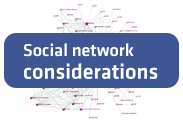 Social networking gives professionals and enthusiastic members of the public a great way to connect and share information about scientific or cultural topics.
Social networking gives professionals and enthusiastic members of the public a great way to connect and share information about scientific or cultural topics.
A niche social network can benefit small, grassroots projects as well as large institutions, achieving many objectives simultaneously. A social network allows members to e.g., exchanging information, making personal connections, fostering dialog and awareness on a topic, as well as fundraising or promoting products and services.
Here are some tips and considerations for getting started… (more…)
- Posted in Strategy
- 1 Comment
- Tags: Audience, community, fundraising, online communities, social media, Social network, user interface
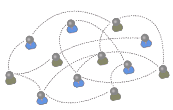 Thinking about launching a new niche social network for a science or cultural community of professionals? Think again. It costs a lot to do well, and there’s a major risk of failure. People don’t have much time to spend logging into yet another social network, and it’s hard to reach a critical mass so that the site is interesting for people to use.
Thinking about launching a new niche social network for a science or cultural community of professionals? Think again. It costs a lot to do well, and there’s a major risk of failure. People don’t have much time to spend logging into yet another social network, and it’s hard to reach a critical mass so that the site is interesting for people to use.
On the other hand, many niche communities still lack a good way to interact online. So there’s a potential need for new social networks.
 Ravelry
Ravelry
Ravelry.com (for knitters and crocheters) is a fantastic example of a thriving niche social network. It has over 1.4 million members (and my wife loves it: she spends more time in there than on Twitter or Facebook). A recent article about Ravelry in Slate talks about how “social sites work better when they’re smaller and bespoke, created to cater to a specific group.” Members share photos and swap tips on their knitting projects. The site was started by a husband & wife team, and now has a 4-person staff. Revenue comes from their online store and advertisers. (more…)
- Posted in Strategy
- 2 Comments
- Tags: Association of Science-Technology Centers, Facebook, social media, Social network, Twitter
 Drones, spy robots, Mach 6 warplanes, new energy sources, and climate monitoring are just a few of the new technologies being developed by the U.S. military to fight the wars of the future. These technologies depend on cutting edge scientific knowledge, and are fantastic ways to get the military-oriented public (nearly 30 million Americans) excited about science and appreciative of the applications of scientific research.
Drones, spy robots, Mach 6 warplanes, new energy sources, and climate monitoring are just a few of the new technologies being developed by the U.S. military to fight the wars of the future. These technologies depend on cutting edge scientific knowledge, and are fantastic ways to get the military-oriented public (nearly 30 million Americans) excited about science and appreciative of the applications of scientific research.
The largest science outreach program telling the public about military-related science is a popular blog, Armed with Science, which features podcasts and short articles by scientists and other staff in various military departments. (more…)
- Posted in Communication
- 2 Comments
- Tags: Audience, blog, community, metrics, military, outreach, social media, United States, visitors
 Today, Nancy Proctor, the head of mobile strategy and initiatives for the Smithsonian Institution, gave an online talk about Smithsonian’s mobile strategy.
Today, Nancy Proctor, the head of mobile strategy and initiatives for the Smithsonian Institution, gave an online talk about Smithsonian’s mobile strategy.
Here are key points and comments Nancy shared about developing mobile products… (more…)
- Posted in Strategy, Technology
- No Comments
- Tags: apps, community, content management, evaluation, exhibits, experiences, metrics, mobile, museum, social media, tablets, visitors
 This weekend, I was a judge at a local chapter of National History Day (NHD). I judged web sites. Amazingly, these sites were much better than those of many small history museums. The students’ sites used a mixture of text, images, video and audio clips in a thoughtful way. This year’s theme was “Debate and Diplomacy.”
This weekend, I was a judge at a local chapter of National History Day (NHD). I judged web sites. Amazingly, these sites were much better than those of many small history museums. The students’ sites used a mixture of text, images, video and audio clips in a thoughtful way. This year’s theme was “Debate and Diplomacy.”
I can’t show you the sites I reviewed, but here are 3 winning examples from 2010: Electrifying America; Polio Pioneer; and Out of the Box, Into the Oven.
- Posted in Business, Communication
- No Comments
- Tags: art, exhibit Design, exhibits, history, museum, online exhibits, social media, virtual exhibit, visitors
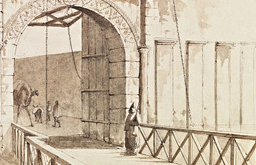 Blogging is an increasingly important way for the public to learn about science and culture. Bloggers fill in the information gaps, as traditional publishers slash jobs for science and arts journalists. More important, for good or bad, bloggers remove the gatekeepers (editors, press officers) which previously stood between experts and the public.
Blogging is an increasingly important way for the public to learn about science and culture. Bloggers fill in the information gaps, as traditional publishers slash jobs for science and arts journalists. More important, for good or bad, bloggers remove the gatekeepers (editors, press officers) which previously stood between experts and the public.
- Posted in Communication
- 2 Comments
- Tags: blog, blog network, journalism, mass media, outreach, social media
Blog networks are collaborative blogs. They give readers an interesting destination, like a newsmagazine, with more content than blogs with just one or a few authors can usually offer. For bloggers, joining a blog network provides more visibility and respect, and allows busy bloggers who can only blog occasionally to build an audience. There are blog networks in most fields. Here’s a snapshot of (most of) the major blog networks in science and culture:
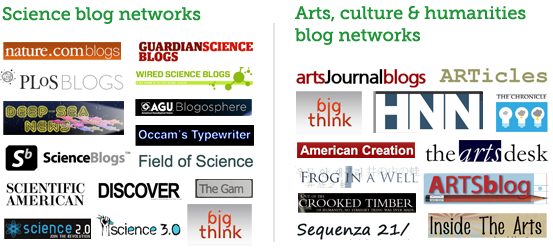
- Posted in Business, Communication
- 2 Comments
- Tags: blog, blog network, outreach, social media, volunteer

